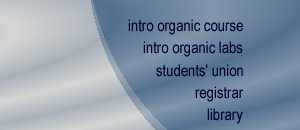












Chem 164/261 - Lecture Outline & Assignment #1
Readings:
Organic Chemistry, L Wade, UA Custom Edition, 2013, Volume 1 (Chem 164/261)
- Functional Group List - Inside Front Cover (also Handout)
- Periodic Table – Inside Back Cover - know 1st 10 elements (up through Neon)
- Relative Strength of Acids and Bases – Table 1.5
- Chapter 1 - Introduction & Review (Structure, Bonding, Resonance, Acids-Bases etc)
- Chapter 2 - Structure & Properties of Organic Molecules (Orbitals, Hybridization, Functional Groups, Intramolecular and Intermolecular Forces etc)
- Chapter 3 – Infrared Spectroscopy (Electromagnetic Spectrum, Molecular Vibrations etc)
Problems:
Do Not turn in, answers available in "Student Solutions Manual for Organic Chemistry" for LG Wade.
Chapter 1:
1.1a; 1.2 to 1.12; 1.15 to 1.19; 1.27; 1.31; 1.34; 1.36; 1.54Chapter 2:
2.1 to 2.11; 2.15; 2.16; 2.18; 2.20 to 2.22; 2.26; 2.28; 2.32; 2.35; 2.40; 2.42; 2.44Chapter 3:
3.12; 3.15
Lecture Outline 1:
Nature of Chemical Bonds, Intermolecular & Intramolecular Forces
- Introduction - Course Organization, Nature of Science and Chemistry
- What is Science?
- What is Matter?
- Basic concepts and definitions - atoms, moles, etc
- What is Science?
- Physical Properties and Purity
- Purity
- Comparison of Physical Properties
- Methods of Purification
- Crystallization
- Distillation
- Extraction
- Chromatography
- Molecular Filtration – Dialysis
- Purity
- Analysis
- Qualitative - Organic or Inorganic
- Quantitative - Calculation of molecular and empirical formula
- Qualitative - Organic or Inorganic
- Atomic Structure
- Theory - wave functions and orbitals
- Periodic Table - Pauli principle, Hund rule, Aufbau
- Theory - wave functions and orbitals
- Molecular Structure
- Ionic bonding
- Covalent bonding
- Molecular orbitals - Linear Combination of Atomic Orbitals (LCAO)
- Hybridization and formation of sigma (s) and pi (p) bonds
- sp3
- sp2
- sp
- Size and Shape of Molecules
- Representation of Molecules
- Lewis Structures
- Formal Charge
- Resonance
- Ionic bonding
- Intermolecular Forces (Forces between different molecules)- van der Waals forces
- Electronegativity and Dipoles
- Dipole-Dipole Interaction
- London Forces
- Hydrogen Bonding
- Electronegativity and Dipoles
- Chemical Reactivity
- Bond Energy and Equilibrium
- Enthalpy
- Entropy
- Equilibrium
- Rate of Reaction and Activation Energy
- Acid-Base Reactions
- Lowry - Bronsted
- Acidity Constant and pKa
- Lewis acids and bases
- Bond Energy and Equilibrium
- Infrared Spectroscopy
A. Electromagnetic Spectrum
B. Origin of Infrared Absorption
C. Utility and Selected Examples (most of this material will be covered in the Laboratory)
